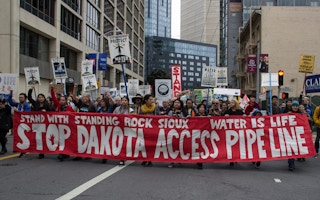When you look to the year ahead, what do you see? Ensia recently invited eight global thought leaders to share their thoughts. In this interview with Ensia contributor Lisa Palmer for Ensia’s 2017 print annual, Judy Hatcher, executive director of Pesticide Action Network North America, responds to three questions: What will be the biggest challenge to address or opportunity to grasp in your field in 2017? Why? And what should we be doing about it now?
Three big news items of 2016 — the national dialogue sparked by the Movement for Black Lives, indigenous-led actions across North America to stop new oil pipelines and the U.S. presidential election — highlight how critical it will be in 2017 to keep equity and human rights at the center of whatever good work we’re doing.
The Building Equity and Alignment for Impact initiative, launched by the Overbrook Foundation, is bringing environmental justice groups and large traditional environmental groups together. National multi-million-dollar institutions have adopted climate justice principles.
Campaigns to stop oil drilling and pipelines from Canada to the Gulf Coast, led by Native peoples and communities most affected by extractive industries, have captured the imagination of millions of people. The emerging food justice movement offers Americans an opportunity to examine how separate issues — including workers’ rights, public health, agriculture and conservation — are fundamentally interconnected and systemic.
The Trump presidency threatens to roll back decades of progress in protecting the natural environment, workers, residents of fence-line communities and consumers, increasing the potential of human health harms, especially for children.
If we step up our commitment to bottom-up, grassroots-led, justice-focused solutions in a proactive united front among environmentalists and with others fighting for an equitable future, we can mitigate the damage.
Inside-the-Beltway groups, especially, can learn much from the multifaceted organizing happening near refineries, commercial transportation hubs, concentrated animal feeding operations, industrial-scale farms and oil pipelines, all of which offer galvanizing examples of emergent strategies that can’t be ignored by policy-makers or by the media.
“
If we step up our commitment to bottom-up, grassroots-led, justice-focused solutions in a proactive united front among environmentalists and with others fighting for an equitable future, we can mitigate the damage.
If we embrace the challenge and opportunity to incorporate the pursuit of justice and equity with respect to race, class and gender into efforts to protect the environment in 2017, we have the potential to exponentially expand the scope and power of the environmental movement beyond the usual suspects and to advance key agendas whatever the political climate might be. The question is, do we have the courage to change ourselves?
Judy Hatcher is the executive directory of Pesticide Action Network North America. Lisa Palmer is a journalist and editor based in Maryland. This article is republished from Ensia.











